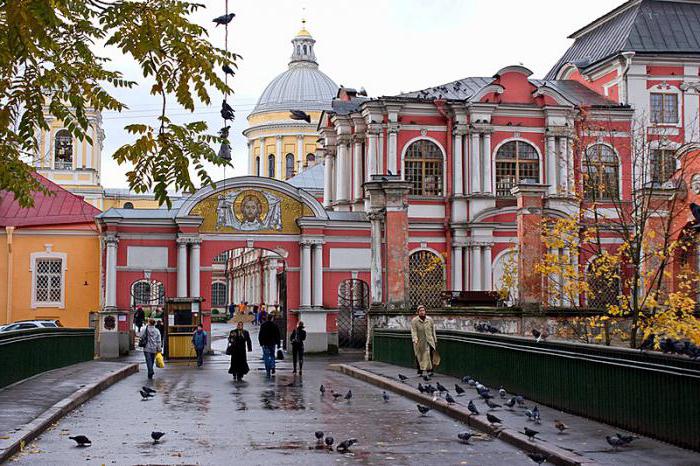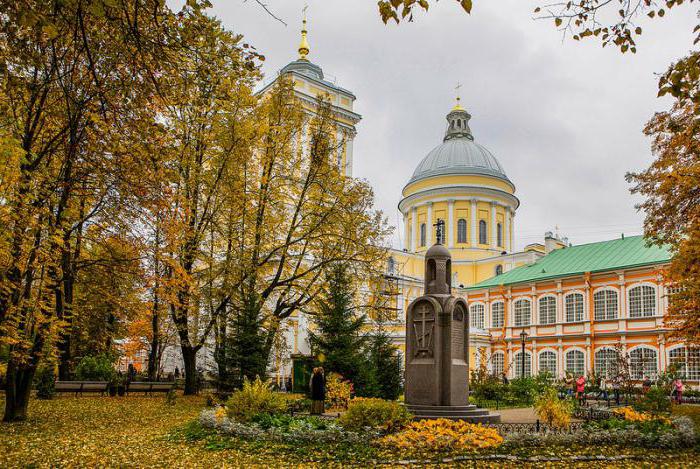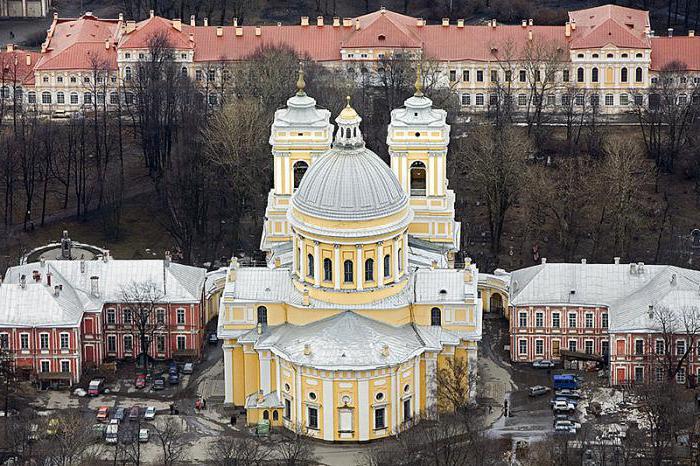Unlike many monasteries that arose in the habitats of hermits, the Alexander Nevsky Lavra was formed by the followers of the church. The name of this holy place is associated with important events in the history of Russia. In 1240, the Grand Duke and commander Alexander Yaroslavovich won a major victory in the war with the Swedes on the Neva River, for which he was called Nevsky. Later canonized by the Orthodox Church as the Holy Patron Saint of Russia.
Today the Holy Trinity Alexander Nevsky Lavra, whose opening hours are very convenient for visiting, is a very popular place for both Russian tourists and foreigners.
The reign of Peter I
The official date of the founding of the Holy Trinity Alexander Nevsky Lavra is March 25, 1713 - the day of illumination of the first wooden Church of the Annunciation. According to historical information, the founder of the Nevsky monastery was the famous emperor Peter I. It was he who in 1702 ordered the construction to begin in the place where the Black River (the real name of the Monastery) flows into the Neva. Archimandrite Theodosius supervised the construction and arrangement of the monastery. The main buildings were designed by Domenico Trezzini, an Italian architect and engineer. In his view, the future Alexander Nevsky Lavra was seen as a whole ensemble of stone buildings located between the Black River and the Neva. The implementation of Trezzini's plans dragged on for many years. During this time, in addition to the main monastery buildings, a whole town appeared here with houses, kitchen gardens, stables, a mill, a forge. A church school was opened here, which was later transformed into a theological seminary, and then into an academy. The relics of Alexander Nevsky were solemnly transferred from Vladimir to the new capital of Russia on September 12, 1724 by decree of Peter the Great. This day is still celebrated in the Russian Orthodox Church . The great commander became the patron of the newly-minted Russian capital, but the massive silver sarcophagus was relocated to the Hermitage in Soviet times, where it remains (without relics) today.

Synodal period
After Domenico Trezzini, Ivan Starov became the main architect of the church buildings, who redid a lot at his discretion, significantly expanding the construction area. In 1797 the monastery was elevated to the rank of laurels. At that time, the Trinity Alexander Nevsky Lavra (St. Petersburg) was not only the largest in the country, but also one of the richest.
Soviet time
During the revolution, the People's Commissar of Social Security A.M. Kollontai wanted to transform the monastery into a haven for war invalids. The group of sailors who went there on January 19, 1918 was met by an angry crowd of parishioners. The Bolsheviks had to retreat. As a result, an order was issued to stop financing the church from the state budget. The apogee of these events was the decree on the separation of the church from the state. In 1922, the monastery was almost “legally looted” in favor of the starving. The silver crayfish, where the relics of Alexander Nevsky were stored, was opened and transferred to the Hermitage, and the relics themselves were transferred to the State Museum fund. From this moment, the Alexander Nevsky Lavra in St. Petersburg continues to operate until 1932, until all the monks were arrested. A year later, the monastery was closed and reorganized into a church parish, and in 1936 the services ceased completely. For the next 20 years, various secular institutions were located on the territory of the monastery, and only in 1957 the services were resumed. The relics of the commander returned to their rightful place only in the late 80s.

Necropolis of the Holy Trinity Alexander Nevsky Lavra. Lazarevskoe cemetery
The Lavra in St. Petersburg is famous for its necropolis, where many famous people of the last century - writers, commanders, scientists, rest. Initially, there was one cemetery - Lazarevskoye, founded during the reign of Peter I. Only the rich or well-known people in the country were honored to be buried here. Today, all tombstones, monuments, sarcophagi are of great historical value. Here is the family crypt of the famous Count Sheremetyev.
Tikhvin cemetery
Over time, the Lazarevsky cemetery became too crowded, and it was decided to open another, which was called Novo-Lazarevsky. It acquired clear boundaries only at the end of the 19th century, when it was surrounded by a stone fence. Around the same time, the new cemetery of the Holy Trinity Alexander Nevsky Lavra was renamed Tikhvin. This was due to the construction of a tomb in the cemetery in the name of the icon of the Tikhvin Mother of God. Burials in the new cemetery are also associated with the names of famous figures of culture, art and the scientific world. Towards the middle of the 20th century, burial at the Tikhvin cemetery ceased, and it was reconstructed into a memorial park.
Nikolskoe cemetery
The third cemetery on the territory of the Alexander Nevsky Lavra was opened in 1863. Since the Nikolskaya Church was located on the territory of the necropolis, the cemetery itself was called Nikolsky. The new cemetery is somewhat different from its counterparts. Firstly, on its territory there are many chapels built in the old Russian style. Secondly, in addition to the usual monuments and crypts, there are many bronze statues and busts of buried people. Thirdly, the Nikolskoye cemetery is the only one in the monastery that has not received the status of a museum. It is valid to this day, but only a few of the most famous people of our time are honored to rest in this holy land.
Every year, many tourists and pilgrims come to St. Petersburg. The purpose of their arrival is the Alexander Nevsky Lavra. Opening hours are very convenient for everyone to enjoy the beauty and tranquility of this place. The cathedral is open from 6.00 to 20.00, the territory of the monastery from 5.30 to 23.00.
History and Modernity
The revival of church life and services within the walls of the monastery began in the second half of the 90s, and in 2000 all the buildings were transferred to the diocese. On the territory of the monastery are two churches designed by the father and son of Trezzini in 1717-1722 and 1742-1750, respectively; the majestic Neoclassical Cathedral, built in 1778-1790 according to the project of Ivan Starov and dedicated to the Holy Trinity, and many structures of a smaller scale. Lazarevskoye and Tikhvin cemeteries are located here, where the richly decorated tombs of Mikhail Lomonosov, Alexander Suvorov, Nikolai Karamzin, Modest Mussorgsky, Pyotr Tchaikovsky, Fedor Dostoevsky, Karl Rossi and other famous people are preserved. Today the Nevsky Monastery is a popular place for tourists and pilgrims. The history of the emergence of the Alexander Nevsky Lavra for all comers will be told by Orthodox guides. On the territory of the monastery there is a refectory and a tea room, where you can order hot meals for both pilgrim groups and individual pilgrims. Three hotels have been built here, in which you can rent comfortable and affordable rooms. Today, the pilgrimage service operates in the monastery, which is responsible for organizing excursions both in the territory of the monastery, and in churches and temples of St. Petersburg.

Birthday of the Alexander Nevsky Lavra
In 2013, the Orthodox Church celebrated the 300th anniversary of the day when the Holy Trinity Alexander Nevsky Lavra was founded in St. Petersburg. The countdown of this event began on March 25, 1713, namely, with the first Divine Liturgy in the walls of the temple. During the celebration, all the brethren, led by the governor of the church, made a procession. Parishioners listened to the congratulations of Metropolitan Vladimir, who urged people to preserve this holy place, which is the spiritual center of all of Russia.
Interesting Facts
Like any ancient place, the Nevsky Monastery is shrouded in secrets and mysteries. Here are just a few interesting facts related to the history of the emergence and development of the Alexander Nevsky Lavra.
- Due to the fact that the monastery was formed on the spot where Alexander Nevsky defeated the Swedes, it was originally called Victoria.
- The Orthodox Academy in St. Petersburg originates from a school built on the territory of the monastery and intended at one time exclusively for the children of clergy.
- The relics of Alexander Nevsky, which were transferred to the monastery during the reign of Peter I and are currently stored there, during the years of the revolution were taken out and transferred to the State Museum.
- In the difficult post-revolutionary period, many clergymen suffered at the hands of the Bolsheviks — they were either shot or arrested.
- In 1918, the government decided to seize the territory of the monastery and use it for their needs. However, the sent detachment met unprecedented resistance of the parishioners and was forced to retreat. After these events, worship continued for another 15 years.
- One of the temples of the laurels is still not included in its possession and is a city museum.
- The construction of this historic complex lasted almost a hundred years. The design and construction of temples and churches was attended by many famous architects and builders of that time.

Latest events
Most recently, on September 12, 2016, the Holy Trinity Alexander Nevsky Lavra in St. Petersburg organized the festival "Neva Ringing" within its walls. The celebrations were timed to the day of the transfer of the relics of Alexander Nevsky and began with the traditional general prayer. The best ringleaders of Russia and neighboring countries took part in the festival and pleased those present with their skill. In addition, a film about bells was presented to the attention of those present. In the final part of the holiday, anyone could not only ring the bell on their own, but also receive a master class from the best bell ringers.